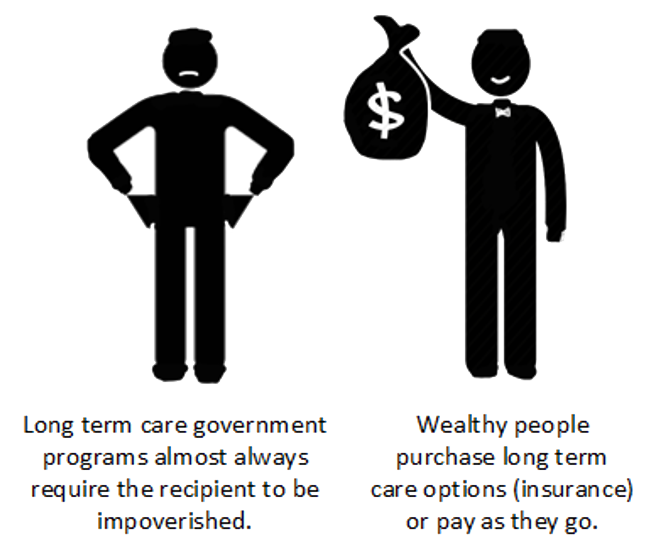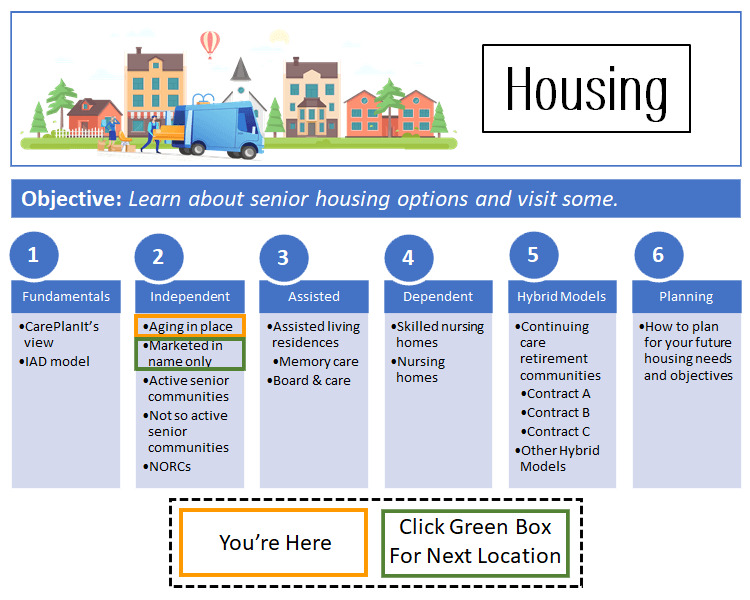What Is Aging In Place?
Click here to see what's on this page.
“Aging in place” as a term means little. We’re all aging. We’re all in a place. Therefore, we’re all aging in place. The reality is “aging in place” refers to seniors wanting to stay where they’ve been for the last ten or twenty years. The homes where they raised children or have been in since they were in their sixties. The home may be a stand-alone home, condo, townhouse, double-wide, or apartment.

CarePlanIt defines the term as seniors who’ve been in a home and choose to stay as they age. In other words, aging in place is the default position for Agers. CarePlanIt’s housing model uses IAD: independent, assisted, or dependent as an axiom of living options. With this in mind, aging in place doesn’t tell you a lot. It’s not a good definition of housing because it doesn’t embody a health state. But we use the definition because it represents how the vast majority of seniors spend the majority of their last years, and what seniors want.
Seniors Want To Age In Place
Aging at home is the preferred place for seniors. It’s what most of us want, what our parents want(ed), and probably what our children will want. The reality is that most seniors living into their eighties will require assistance and if they long enough, require dependent care. This desire and reality are being reflected in government policies.
Always keep in mind that long-term care is very expensive. Annual costs for assisted living run between $36,000 and $250,000. The spread is between paying for only a few hours a day of in-home caregivers or using them 24 hours a day or moving into an assisted living facility. Skilled nursing care at home or moving into a skilled nursing facility runs annually between $120,000 and $500,000. The spread is for the same reason.
What You Need To Know About The New Aging In Place Movement
The term “aging in place” has become a very powerful term of art. Like the term “child care” has done over the last thirty years, “aging in place” is creating a tidal wave of effects. Understand these effects and you’ll make better decisions, find resources faster, and live better. The term has real meaning in the following areas:
The Politics of Aging In Place
The Centers for Disease Control and Prevention (CDC) has a definition for aging in place: “the ability to live in one’s own home and community safely, independently, and comfortably, regardless of age, income, or ability level.” Governments and policymakers are adopting this definition and it’s impacting legislation.
Here’s one example of how it works. The CDC researches senior health and well-being. They bring in experts, commission research reports, and conduct surveys. When they reach definitions and conclusions, they turn these into policy recommendations. Government entities that allocate funds for seniors take recommendations from CDC seriously. For example, the CDC believes those “aging in place” should be able to receive care or assistance from local, even family, caregivers. This is great news for seniors and suggests that government programs will continue moving toward paid-for, in-home services. Even those where family provides the services.
Legislation Has Adopted The Meaning Of Aging In Place
Many of the original legislative acts supporting seniors have as their primary objective allowing seniors to live on their own terms, which included things like adequate income, suitable housing, dignity, honor, freedom, and autonomy. The “aging in place” movement is the modern terminology supporting these objectives. The current iteration of senior government agencies uses the term community-based living.
In fact, what was once called the Administration on Aging (AoA) is now under the Administration for Community Living (ACL). Community living encompasses aging in place. So it’s logical that a community should be capable of supporting aging in place. Or at least make efforts.
Seniors are excited about this move toward supporting in-home aging. But seniors need to be realistic about how these goals will be executed. The government will look for economies of scale. Areas where services get their biggest bang for the buck. High-density areas, or areas within a few miles of large-scale medical services (e.g., hospitals, large skilled nursing facilities, etc.) are where this happens. You can use this knowledge to choose homes that are in or near larger cities.
The Government Is Starting To Support Seniors At Home
Although the government is starting to support aging in place, that support is not focused on dependent care. The government won’t cover full long-term care costs unless it absolutely must. It’s too expensive. When it must, it requires the recipient’s poverty. This poverty qualifies you for Medicaid (your State’s version).

Government In-Home Health Support Services – Skilled Care
The government now actively supports and pays for home healthcare at home to help seniors age in place. In-home health care, also called home healthcare includes:
The most common home healthcare visits are from nurses and physical therapists. Visits usually follow hospitalization or a stay in a skilled nursing home. Government programs like Medicare and Medicaid pay for these services. Because Medicare covers these services, seniors are generally entitled to this type of in-home healthcare.
Government In-Home Care Support Services – Non-Skilled
Home care is non-skilled care or home care. This type of care is focused on maintaining a senior’s quality of life in their home. It’s all about comfortability and safety. This type of care can be provided by nonprofessionals. It includes the following.
This is the care people generally associate with watching a senior who has become frail and forgetful. Care that helps a senior maintain their basic needs and stay safe. This care is generally not provided by Medicare. However, Medicaid provides these services under certain programs.
Medicaid Programs Providing Home Care
The aging in place wave has pushed the Federal Government to allow states to fund and manage programs that support home care. These programs are funded by Medicaid and available only to those seniors qualifying for Medicaid. This class of programs is called Self-Directed Services. They fall into one of the four categories below.
Does The Government Pay For Relatives To Care For Seniors?
In some cases, the federal government is allowing states to manage programs that pay for home care. The usual model is for an agency to get paid, and the agency provides the home care worker. However, there are some states that allow payment to be made directly to the senior, and that senior can hire a relative to provide home care.
If you live in a state where you qualify, the program might be appealing to a family member. If you plan to move to a state where you’d qualify, the extra help from a relative might create more time to spend with family. Also, keep in mind that many senior communities have defined rules about who can live in a senior department.
Financial Implications Of Aging In Place
Financial problems arise when a senior trying to age in place needs assisted or dependent care. Assisted care generally involves IADLs and help with one or two ADLs. Dependent care requires help with most or all of the ADLs. These cost money. So aging in place requires financial resources.
Government support for the elderly in the area of healthcare roughly falls into two areas, Medicaid and Medicare. Medicaid is only for the poor. If you can’t qualify for Medicaid you’ll need to fund your own home care. The bulk of these resources must come from the Ager, the Ager’s family, and the Ager’s community (religious organizations, neighbors. etc.). Government assistance is available, but not in the form of aging assistance per se. Instead, most government assistance supporting aging at home tends to come from government programs supporting the poor. This can be a great supplement to living at home. The big categories are health, food, and housing. Learn more about these here.
Political Pressue Is Pushing Suppoort In Home
The aging in place movement is supporting government programs that provide in-home help. Services that help with IADLs like senior transportation, shopping services, in-home health visits, and meal programs help seniors stay home. Government programs and private organizations are supporting these services.
Government Programs Do Not Support In-Home Dependent Care
Dependent care, or nursing level care represents a significant challenge. The government is unlikely to ever provide this level of care. It’s too expensive. In-home nursing care would cost the government between 100,000 and 500,000 a year. Also, an Ager’s home would have to be modified for safety purposes. This might cost another $25,000 to $100,000.
This said, if Agers lives collectively in group environments set up to safely accommodate in-home (or in-room) nursing level care, the government might supplement the care. Currently, it’s the providers (housing and health care companies) that create these environments and then contract with the government for the services they provide. Agers without financial resources seek to qualify for nursing homes through impoverishment and medical need. The Agers that live in these environments turn over their social security, Medicaid, and other resources to the provider. In short, the Ager runs out of money and their medical needs qualify for Medicaid support which many nursing homes accept.
The exception is some experimenting with NORCs. In these communities, the government is extending more and more local services. These are things like in situ doctors, nurses, and physical therapists. Once they’re in the building, visiting individual apartments or condos is pretty easy. If the senior needs help, bringing them down to the office in a wheelchair is also pretty easy. It’s possible that these experiments will result in models that may ultimately support some level of ADL help for senior’s trying to age in place.
Housing & Health Care Implications of Staying In One’s Own Home
The aging in place wave has reverberated into the housing industry. CarePlanIt has described how the housing industry, especially the assisted housing industry, now offers more health-related services. This allows seniors living in certain senior communities to remain living there longer than if they provided no health services.
Even housing communities that don’t focus on or provide in-home healthcare offer a variety of wellness programs. These include everything from exercise programs to nutrition classes.
The senior housing industry is keenly aware of seniors’ desire to age in place. Many builders are considering these desires in their new home construction. Features that address aging in place are:
If you currently like where you live, and want to stay there, it makes sense to make modifications that will help you over time. Review our section on retrofitting or remodeling for aging in place here to learn about what seniors are doing to age in place.
Cultural Implications of Aging In Place
All cultures value the home. It represents contentment, safety, and security. Studies show that homeownership is linked to a greater sense of community, lower crime, prosperity, and better outcomes for children. Homes are associated with status, independence, and stability. Our homes and communities are where we have our friends. We plan our life in relationship to our home. This is why the United States government encourages homeownership and supplements the home lending industry. It has been doing so for generations.
Age on the other hand has become associated with disease. An illness to be combated and cured. Our homes represent health and vitality. Leaving our home is like acknowledging that we are sick. Or that we are giving up our vitality and health. This is why it is so hard for seniors to leave their homes and live somewhere else.
Focus On CarePlanIt’s IAD Model Of Housing
This is why CarePlanIt encourages all seniors to consider the IAD model of housing. Understanding that as our needs increase, our ability to stay home decreases. This is reality. If we understand this and start to make plans for changing homes in the future, if we have to change homes, the separation is more tolerable.
Other Resources On Aging In Place
A good government resource on aging in place here.
Another good resource on aging in place here.
